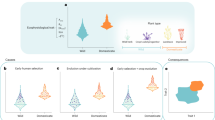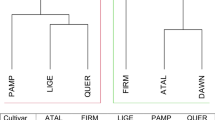Abstract
ALTHOUGH much work has been done on the widely cultivated species of rice (Oryza sativa Linn.) for its improvement as an agricultural crop, it must be admitted that our knowledge of its morphology and taxonomy and its relationship to other wild species of the genus is comparatively meagre. The term ‘wild rice’ as employed here is used to indicate all other species which conform by their technical characters to the generic definition of Oryza, and which grow spontaneously in a wild state. The two cultivated species are the well-known Oryza sativa Linn, and the less known Oryza glaberrima Steud. (cultivated in west tropical Africa). In tropical countries where these species are extensively cultivated, it is unfortunate that a comprehensive account of the rice plant with a proper interpretation of al the structures, its evolution and domestication by man is not generally given in text-books on botany and tropical agriculture. This omission makes its study uninteresting and often vague. The aim this note is to put together some of these much-needed data with a suitable list for further reference.
This is a preview of subscription content, access via your institution
Access options
Subscribe to this journal
Receive 51 print issues and online access
$199.00 per year
only $3.90 per issue
Buy this article
- Purchase on Springer Link
- Instant access to full article PDF
Prices may be subject to local taxes which are calculated during checkout
Similar content being viewed by others
References
Chevalier, A., Rev. Bot. Appl. et Agric. Trop., 12, 1014 (1932).
Backer, C. A., Blumea, Suppl. 3, 45 (1946).
Burkill, I. H., âœDict. Econ. Prod. Mal. Penin.â, 2, 1592 (1935).
Prain, D., âœBengal Plantsâ, 2, 1184 (1903).
Roschevicz, R. J., Bull. Appl. Bot. Genet. et Pl. Breed., 27, 3 (1931).
Stapf, O., Hook.f. in Trim. Fl. Ceyl., 5, 182 (1900).
Cooke, T., âœFl. Bomb.â, 2, 1042 (1908).
Graham, R. J. D., Mem. Dep. Agric. Ind., 6, 222 (1913).
Arber, A., âœThe Gramineaeâ, 184 (1934).
Hubbard, C. E., âœHook. Iconesâ, 3232 (1934).
Michaud, V., Bull. Torr. Bot. Club, 71, 624 (1944).
Peterson, N. F., Nebreska Acad. Sci., 6 (1935).
Parodi, L. R., âœPrimera Reunion de Agronomiaâ, 55 (1941).
Rossberg, G., Doctorate Thesis, University of Berlin (1935) Reviewed by C. E. Hubbard in J. Bot., 74, 143 (1936).
Prodoehl, A., Bot. Archiv., 1, 211â224, 231â255 (1922).
Bews, J. W., âœWorld Grassesâ, 122 (1929).
Bor, N. L., âœFlora of Assamâ, 5, 171 (1940).
Watt, G., âœDict. Econ. Prod. Ind.â, 5, 504 (1891).
Copeland, E. B., âœRiceâ (1924).
Jack, H. W., Malay Agric. J., 5, 11 (1923).
Kikkawa, S., J. Coll. Agric. Tokyo, 11â108 (1912).
Peake, H., âœThe Origin of Agricultureâ (1928).
Roy, S. C., Agric. J. Ind., 16, 365 (1921).
U.S. Yearbook, Dept. Agric., 415 (1936).
Vavilov, N. L, âœOrigin of Cultivated Plantsâ in Bull. Appl Bot. et Pl. Breed., 16 (1926).
Author information
Authors and Affiliations
Rights and permissions
About this article
Cite this article
CHATTERJEE, D. Botany of the Wild and Cultivated Rices. Nature 160, 234–237 (1947). https://doi.org/10.1038/160234a0
Issue Date:
DOI: https://doi.org/10.1038/160234a0
This article is cited by
-
Wild and Cultivated Rice
Nature (1947)
Comments
By submitting a comment you agree to abide by our Terms and Community Guidelines. If you find something abusive or that does not comply with our terms or guidelines please flag it as inappropriate.



